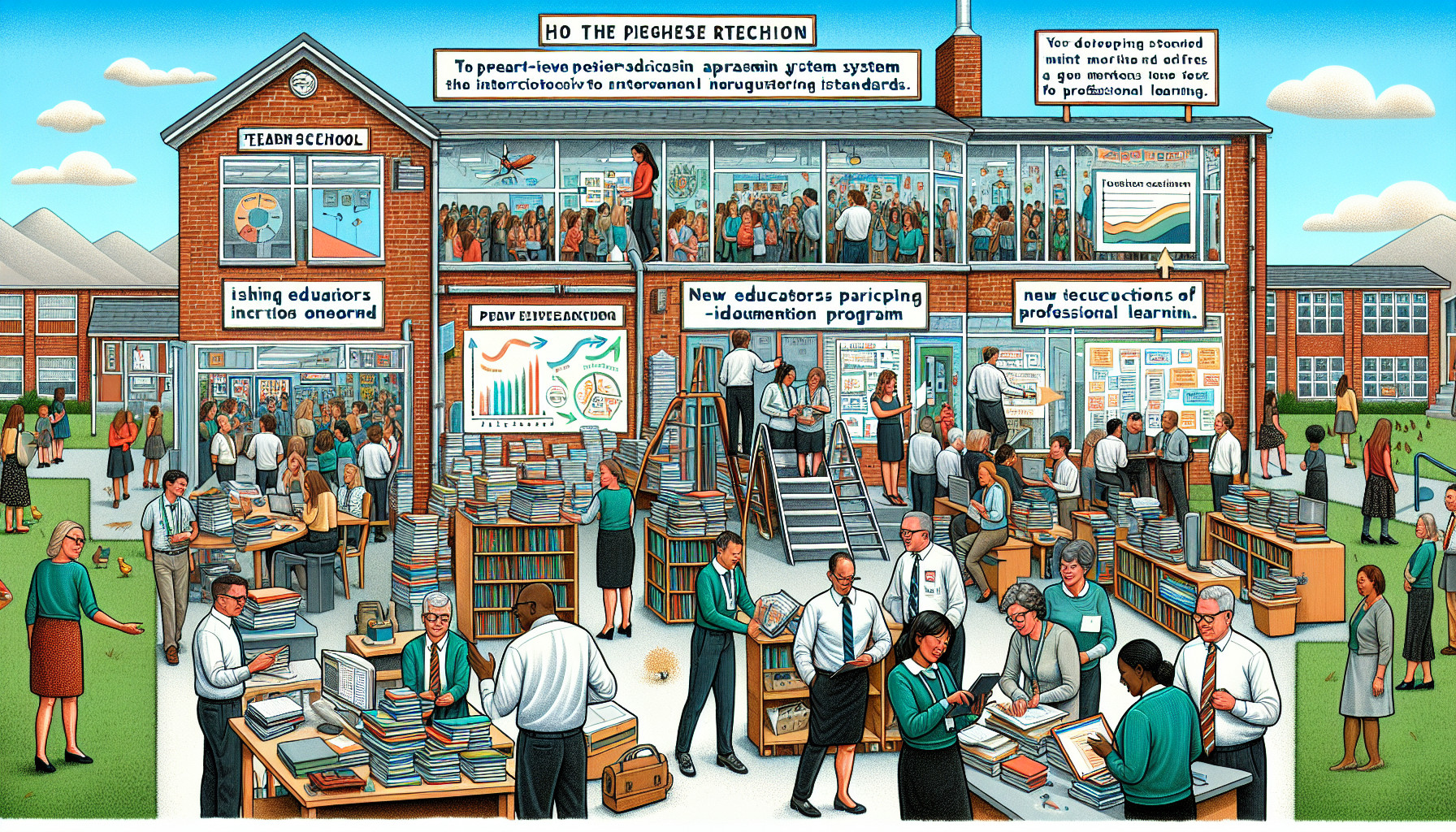Navigating the standard of teaching is essential for educators striving to deliver a high-quality educational experience. This article examines the concrete standards guiding teachers, the influence on their professional development, and the practical applications within the classroom. We offer a straightforward look at how these standards serve as the backbone of effective teaching without revealing too much of the journey that unfolds in the following sections. Prepare to understand the building blocks of exceptional education and the commitment required to uphold them.
Key Takeaways
Teachers’ Standards provide a statutory framework for professional practice, ensuring quality, accountability, and continuous improvement in teaching, with clear routes for achieving and assessing Qualified Teacher Status (QTS) and ongoing professional development.
Continuous Professional Development (CPD) is essential for all teachers, from early career to experienced educators, enabling them to keep pace with educational standards, adapt to legislative changes, and support their institutions’ visions and collective objectives.
The practical application of Teaching Standards in the classroom includes effective classroom management, designing well-structured lessons, strategic assessment and feedback, and upholding ethical personal and professional conduct, all of which contribute to high-quality education.
Understanding Teaching Standards

Teaching standards are not mere guidelines; they are pillars holding up the edifice of education. These standards provide a clear and comprehensive framework for teachers’ professional practice, steering quality assurance, professional development, accountability, ethical conduct, reflection, and improvement. Imagine them as a well-drawn map, providing a clear route for teachers to navigate the complex landscape of education. They are statutory, meaning teachers are legally required to follow them unless there’s a justified reason not to do so.
First introduced in July 2011 and last updated in December 2021, the Teachers’ Standards outline the responsibilities and expectations for teachers across various career stages. These standards were not created in a vacuum. The impact of teaching quality on students’ achievement was a key consideration in their development, as emphasized by Dame Sally Coates. The standards serve as a clear baseline, ensuring that every student, regardless of their background, has access to a high standard of education.
The Essence of Qualified Teacher Status
So, how does one become a qualified teacher? The journey begins with meeting the Teachers’ Standards, which act as a foundational benchmark for the teaching profession. To ensure these standards are met at the entry level, initial teacher education programs assess trainees against these contemporary Teachers’ Standards for qualified teacher status.
Achieving qualified teacher status is just the beginning. After initial qualification, schools use the Teachers’ Standards to judge the performance of trainee and early career teachers during their induction period to guarantee competency. The Standard for Full Registration signifies a critical threshold into the teaching profession, ensuring that teachers possess the requisite competencies and instilling confidence in their abilities.
It’s like a rite of passage, marking the transition from a trainee to a fully-fledged teacher.
The Impact of Professional Standards on Teaching Practice
Professional standards are the compass that guides every teacher’s actions, covering critical areas such as professional knowledge, teaching expertise, knowledge sharing, support for learners with educational difficulties, and professional responsibilities. These standards, rooted in professional values, support teachers in mastering essential competencies like planning, motivation, coaching, and assessment strategies.
But it doesn’t stop there. Professional standards also provide a framework that helps teachers develop their professional identity, deeply committed to the cognitive, social, and emotional growth and wellbeing of all learners. A critical aspect of developing teacher professionalism is the commitment to reflective practice, connecting values with actions, and pursuing career-long professional learning – all of which are encouraged by adherence to professional standards. It’s like a mirror, reflecting on what you’ve done and what you can do better, fostering a continuous cycle of learning and growth.
Elevating Teaching through Continuous Professional Development

In the ever-evolving landscape of education, continuous professional development (CPD) is the wind beneath a teacher’s wings. It is vital for teachers to keep pace with evolving educational standards and ensures the delivery of high-quality teaching with a positive impact on pupil outcomes. Think of it as a tool that sharpens your skills, keeping them up-to-date and relevant.
But CPD doesn’t benefit only the teachers. It is instrumental for the growth of schools or academy trusts by supporting their visions and creating a unified direction for staff towards collective objectives. Engaging in continuous professional development enhances teacher motivation, confidence, and dedication, contributing to a more productive and effective teaching environment. CPD can be achieved through various methods, including:
workshops
observations
online courses
other training sessions that are mapped to professional teaching standards
It’s like an investment that pays dividends in the form of better teaching outcomes.
Crafting a Path for Early Career Teachers
For early career teachers, the teaching landscape can be challenging to navigate. This is where continuous professional development (CPD) plays a significant role. It is crucial for early career teachers to focus on their own professional development to improve their teaching skills and prepare them to meet contemporary challenges like virtual learning and evolving student needs.
Early career teachers are encouraged to pursue diverse professional development opportunities to enhance the quality of their teaching and facilitate their professional advancement. Initiatives like the Oak National Academy, specifically for initial teacher training, significantly contribute to reinforcing subject-specific training support. It’s like a compass, guiding new teachers in their journey towards becoming proficient educators.
Advanced Growth for Experienced Educators
For experienced educators, professional development plays a different but equally important role. It supports both teaching and support staff who contribute significantly to learner development. Advanced professional development programs are designed to enhance these educators’ ability to adjust to new legislation and teaching methods, positioning them as leaders during uncertain times.
Specialized online courses provide experienced educators the flexibility to pursue professional growth and expertise in specific skills. The Standard for Career-Long Professional Learning offers an aspirational and developmental framework that supports educators in shaping their professional identity and advancing into leadership roles. It’s like a roadmap, guiding experienced educators on their journey to becoming educational leaders.
Teaching Standards in the Classroom: Practical Application

Applying teaching standards in the classroom transforms these guidelines from theory to practice. The Department for Education’s Teachers’ Standards set expectations for educators to:
Manage behavior effectively
Establish clear rules and routines
Maintain a conducive learning atmosphere through consistent and impartial application of praise, sanctions, and rewards
It’s about fostering an environment where students feel motivated and empowered to learn.
Effective classroom management includes employing methods tailored specifically to engage and motivate students, build good relationships, and maintain an authoritative presence. Teachers must recognize and cater to different student abilities and interests by using diverse teaching and assessment strategies, employ scaffolding, and differentiate lesson plans, taking into consideration students with learning differences, behavioral problems, or special needs. Techniques such as incorporating key vocabulary, linking lessons to prior knowledge, and engaging in cooperative learning are essential to support the breadth of student needs.
Designing Well-Structured Lessons
Well-structured lessons are the backbone of effective teaching. Professional teaching standards support teachers in devising these lessons, which foster a strong affection for learning among students. Teachers can teach well structured lessons by:
Being current with lesson planning methodologies
Using student progress data to tailor future lesson plans
Including a ‘prior learning’ section in their planning template
Setting relevant homework
Suggesting out-of-class activities
Differentiated instruction enriches well-structured lessons by incorporating diverse assessment methods, allowing pupils to demonstrate their understanding in a way that aligns with their individual abilities and needs. It’s like a customized learning plan, catering to the unique needs of every student.
Assessment and Feedback Strategies
Assessment is the compass that guides teaching, ensuring that it stays on the path of effective learning. Making accurate and productive use of assessment involves marking books quickly and regularly, providing meaningful feedback and targets, and keeping consistent records. Feedback mechanisms like exit tickets at the end of lessons enable teachers to gather formative feedback, which is crucial for assessing student understanding and confidence, thereafter guiding the planning for future lessons.
Differentiated instruction caters to the varied ways students acquire and process information and is enhanced by the use of assessment to understand diverse learning needs. It’s like a tailor-made suit, fitting perfectly to each student’s unique learning style.
Upholding Personal and Professional Conduct

As educators, teachers carry a significant responsibility not only in imparting knowledge but also in upholding high standards of personal and professional conduct. Teachers in England are expected to adhere to Teachers’ Standards which define the minimum level of practice and conduct for classroom teaching as well as personal and professional behavior.
Part of professional conduct for teachers includes:
Maintaining professional boundaries
Adhering to school policies and statutory frameworks
Ensuring a safe learning environment
Respecting the dignity of pupils
Treating pupils with respect and dignity
Avoiding expressing personal beliefs in a way that might exploit vulnerabilities or incite illegal behavior.
Upholding fundamental British values such as:
democracy
the rule of law
individual liberty
mutual respect
are integral to the ethical responsibilities expected from teachers. It’s like a moral compass, guiding teachers on the path of ethical and professional conduct.
Ethical Considerations in Teaching
Ethics in teaching goes beyond the classroom and into the very heart of decision-making. Ethical decision-making in the education sector is recognized as a core competence, and is essential for resolving ethical issues that arise in teaching.
It’s the light that guides teachers in the gray areas of ethical dilemmas.
Role of the Teaching Regulation Agency
The Teaching Regulation Agency (TRA) is the watchdog of the teaching profession in England. It operates under The Teachers’ Disciplinary (England) Regulations 2012, overseeing misconduct hearings and maintaining a record of teachers and trainees. When allegations of misconduct arise, the TRA references Teachers’ Standards to determine breaches in professional conduct, and serious cases may be referred to a professional conduct panel which investigates the matter.
If a teacher is found guilty of serious misconduct, the TRA can issue a prohibition order, listing the teacher’s name on a prohibited list and banning them from teaching in England. Professional conduct panels are composed of individuals from within and outside the teaching profession, including a current or recent teacher, a layperson, and a former teacher, with legal advisement present during proceedings. It’s like a court of law, ensuring that justice is served in the teaching profession.
The Role of Schools in Supporting Teaching Standards

Schools are the crucibles where teaching standards take shape. They implement appraisal systems as a formative process to ensure teachers are equipped with necessary skills, encouraging professional dialogue. Induction programs provided by schools help new teachers adjust to the profession and the school’s culture, aligning them with expected teaching standards.
Access to resources for continuous professional learning is critical for teachers to maintain and improve upon existing teaching standards. It’s like a toolbox, providing teachers with the resources they need to meet and exceed teaching standards.
School Teachers’ Appraisal and Support Systems
Teacher appraisals are a crucial part of professional development. They set objectives that are specific, measurable, achievable, realistic, and time-bound, with a maximum of three objectives per teacher to maintain focus and clarity. Appraisers for teachers are chosen to be qualified teachers with current or recent teaching experience to ensure fair and knowledgeable evaluation.
Appraisal policies include provisions for teachers to receive training and development opportunities linked to the school’s continuing professional development program. The appraisal process includes support for teachers experiencing difficulties, aiming for an improvement in performance to resolve issues before moving to formal capability procedures. Schools utilize various resources, including guidance and checklists, to ensure that the appraisal of teachers leads to a positive experience.
It’s like a compass, guiding teachers towards professional growth and excellence.
Induction and Mentoring for New Teachers
Being a new teacher can be daunting. The world of teaching is vast and complex, and it can be easy to feel lost. This is where induction and mentoring come into play. Newly qualified teachers undergoing induction are typically excluded from the standard appraisal process, highlighting the tailored support during their initial phase. Principals play a significant role in inducting new teachers with tools and resources that can be tailored to each school’s needs.
New teachers receive time away from classroom duties to engage with supports and have a dedicated mentor to help develop their teaching practice. Mentorship for new teachers includes formal training programs that focus on wellbeing, professional practice, and developing a professional identity. Graduate teachers have opportunities to attend workshops to strengthen their teaching practice, improve wellbeing, and build their professional identity. The Teacher Standards PDF is essential as it includes information to support teachers in their role and ensure they are meeting the expected standards, serving as an important guide during the ECT induction period. It’s like a guiding hand, supporting new teachers as they navigate the complexities of the teaching profession.
Adapting Teaching Standards to Evolving Educational Needs
Education is not a static field. It is constantly evolving to meet the changing needs of students and society. In 2021, the Professional Standards for Teachers and Trainers underwent a review. This was prompted by the rapid changes in working practices, digital learning during the Covid-19 pandemic, and emerging sustainability and wellbeing challenges..
Continuous Professional Development (CPD) ensures that teaching professionals stay compliant with the latest requirements from the Department for Education and Ofsted, adapting to changes in legislation as part of evolving teaching standards.
The Role of Initial Teacher Education
Initial teacher education programs play a crucial role in preparing teachers to meet these evolving educational needs. They are adapting their curricula to better support pupils who require the most assistance, particularly those from diverse backgrounds. By learning to adapt teaching methods, there is an emphasis on developing the critical epistemic reflexivity of teacher educators within ITE programs to tackle the complexities associated with teaching a diverse student population.
Research highlights a need for initial teacher education programs to deepen their engagement with specialist literature, especially on topics of gender and race, to foster an inclusive approach to diversity in education. It’s like broadening the horizon, equipping teachers with the skills and knowledge to meet the diverse needs of their students.
Incorporating Out-of-Class Activities
Learning doesn’t stop when the school bell rings. Out-of-class activities are integral to Teachers’ Standards, emphasizing a well-rounded education that supports both student learning and professional growth of educators. Planning and implementing out-of-class activities is recognized by the Teachers’ Standards as a way to enrich pupil experiences and enhance their knowledge beyond the classroom environment.
Involvement in out-of-class activities allows teachers to contribute significantly to the broader life and ethos of the school, in line with the Teachers’ Standards. It’s like opening a window to the world, enriching students’ learning experiences beyond the confines of the classroom.
Summary
In the grand tapestry of education, teaching standards are the threads that weave together to create a vibrant and effective learning environment. They guide teachers on their journey to professionalism, ensuring quality assurance and continuous improvement. From understanding the essence of qualified teacher status and the impact of professional standards on teaching practice, to elevating teaching through continuous professional development and upholding personal and professional conduct, teaching standards are at the heart of a high-quality education. They adapt to the evolving educational needs, ensuring that teachers are equipped to meet the diverse needs of their students. As educators, let’s continue to strive for excellence, guided by these standards, to create an enriching and empowering learning environment for our students.
Frequently Asked Questions
What is standard 3 teaching?
Standard 3 teaching involves demonstrating good subject and curriculum knowledge, fostering and maintaining pupils’ interest in the subject, and addressing misunderstandings. It also entails being aware of pupils’ capabilities.
Why are there teaching standards?
Teaching standards are in place to ensure high-quality education for students and contribute to improved academic success. Additionally, they provide clarity on the key areas for self-evaluation and professional development for teachers.
What is teacher standard 7?
Teacher Standard 7 requires teachers to manage behavior effectively to ensure a good and safe learning environment, with clear and consistent expectations for excellent behavior and learning behaviors.
What are teachers standards?
The Teachers’ Standards create a framework for professional development and outline expectations for both teaching quality and personal conduct. They are used in assessing trainees and teachers throughout their careers.
How does one achieve qualified teacher status?
To achieve qualified teacher status, you need to meet the Teachers’ Standards, which serve as the benchmark for the teaching profession. This is the key requirement for attaining qualified teacher status.


